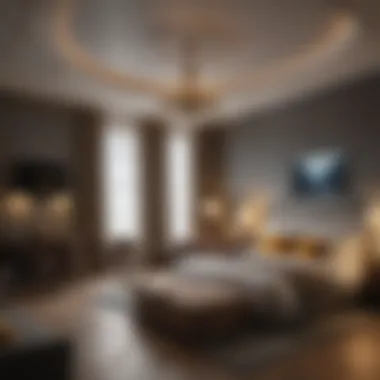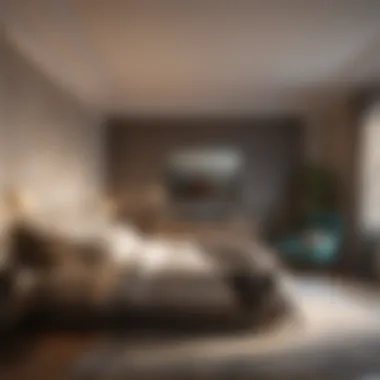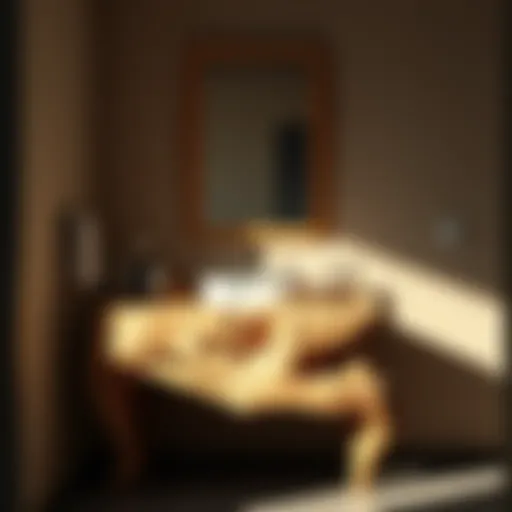Enhancing Your Space with Bedroom Projectors and Screens


Intro
The growing trend of optimizing personal spaces for multimedia consumption is gaining momentum. In recent years, bedroom projectors and screens are becoming essential elements for crafting a superior viewing experience. Not only do these tools facilitate entertainment, but they also serve as focal points in bedroom design. This article seeks to provide a detailed overview of the various factors involved in selecting and integrating projectors and screens into bedroom aesthetics, emphasizing both functionality and style.
Understanding the intricacies of different projector types, screen materials, and placement strategies is crucial. This guide will explore advancements in technology that enhance usability, as well as decor choices that align with modern lifestyles. For homeowners and renters alike, elevating the bedroom media experience may lead to significant satisfaction and enjoyment.
Trending Styles
Modern Minimalism
Modern minimalism has become a defining style in many contemporary bedrooms. It features sleek designs with clean lines and an emphasis on function over form. When incorporating projectors and screens into this design philosophy, a seamless integration is key. A projector that blends into the decor without drawing attention can be ideal. Ultra-short throw projectors are one option, as they can be mounted close to the wall and require minimal space.
Screens, too, should complement this aesthetic. Choosing a retractable screen that disappears when not in use aligns perfectly with the minimalist approach. Materials like matte white for screens ensure that colors appear vivid without disrupting the simplicity of the room.
Cozy Rustic
On the other hand, the cozy rustic style creates a warm and inviting atmosphere. This aesthetic often incorporates natural materials like wood and textiles. Projectors in rustic settings can be chosen to reflect the room's warmth. A wooden-framed projector is a unique choice, as it adds charm while providing functionality.
Screens in cozy rustic spaces can benefit from textures such as linen or burlap, contributing to the cozy feeling. Using warm, ambient lighting alongside the projector can enhance the viewing experience, creating a setting that encourages relaxation and enjoyment.
Color Palettes
Calming Neutrals
Choosing the right color palette impacts the overall feel of a bedroom. Calming neutrals like soft greys, whites, and beiges foster a serene atmosphere. Projectors with a low light output that supports these tones ensure the picture quality remains high and even during daylight usage.
Pairing these projectors with screens that feature a neutral color helps maintain a cohesive look. Such combinations work better in spaces designed for relaxation and unwinding, important for bedrooms intended as sanctuaries from daily stresses.
Bold Accents
Alternatively, some may prefer bold accent colors to inject personality into the space. In this case, one can select projectors and screens that either contrast with the room or highlight its vibrant features. For example, a projector with customizable skins or a screen with a funky pattern can serve as conversation starters. This approach allows homeowners to express their unique style while enjoying high-quality visuals.
"Integrating multimedia elements into bedroom design is not just about functionality; it's about crafting a personal refuge that resonates with individual tastes and preferences."
Prolusion to Bedroom Projectors and Screens
Bedroom projectors and screens have become an essential aspect of modern home entertainment. These devices unlock a new experience that offers flexibility and immersion that traditional TVs cannot match. The convergence of technology in compact formats enables unique setups in bedrooms, optimizing space while enhancing user experience. As home media preferences evolve, understanding the characteristics of projectors and screens can significantly impact one’s enjoyment and comfort during viewing.
The Evolving Role of Projectors in Home Entertainment
Projectors have reshaped the landscape of home entertainment by providing alternatives to conventional televisions. They adapt to various room sizes and personal tastes, allowing for large-scale viewing without the bulk of a large TV set. Their role is evolving with technology advancements, from recreational use to being integral in creating an immersive experience. More individuals and families regard projectors as versatile tools for various occasions like movie nights, gaming events, or even professional presentations in a more intimate setting. As this trend continues, understanding projector types and their functionalities becomes increasingly valuable.
Benefits of Using a Projector Over a Traditional TV
Choosing a projector over a traditional television offers several advantages:
- Screen Size Variability: Projectors can display images from 40 to 300 inches, accommodating larger screens without significant space usage.
- Portability: Many projectors are lightweight, enabling easy relocation within the home. This makes them practical for indoor or outdoor activities.
- Enhanced Viewing Experience: With advanced technologies like 4K and HDR, projectors provide remarkable image quality, enhancing color vibrancy and detail.
- Lower Costs for Bigger Screens: For those desiring a larger viewing space, projectors may present a more economical option than oversized TVs.
"Projectors can go way beyond the confines of traditional TV, bringing unique experiences directly into your personal space."
The benefits are compelling, making projectors an attractive choice for homeowners and renters looking to elevate their viewing experiences. Consequently, they are becoming a focal point in modern bedroom design considerations.
Understanding Different Types of Projectors
In the realm of multimedia entertainment, particularly in bedroom environments, the choice of projector is crucial. Understanding different types of projectors helps homeowners make informed decisions tailored to their specific needs and preferences. Each projector type has unique features, benefits, and considerations that can affect the overall viewing experience. Knowing these distinctions allows users to select the projector that best aligns with their room dimensions, ambient light conditions, and desired image quality. With this knowledge, homeowners can transform their bedrooms into fulfilling entertainment spaces.
DLP Projectors: Features and Advantages
Digital Light Processing (DLP) projectors utilize a microchip and mirrors to project images. They are renowned for producing bright, sharp images with vibrant colors. One significant advantage of DLP projectors is their compact size, allowing them to fit in limited spaces. The technology also provides fast response times, reducing motion blur. Moreover, DLP projectors are generally easier to maintain due to fewer internal components susceptible to dust.


However, one should note the issue known as the "rainbow effect," which some viewers experience, especially in scenes with high contrast. Overall, DLP projectors are a robust choice for those seeking performance in a compact form.
Projectors: Performance Metrics
Liquid Crystal Display (LCD) projectors are known for producing excellent color reproduction and detailed images. They work by using liquid crystals manipulated by electric currents to create images. These projectors often provide a more stable image without the "rainbow effect" found in some DLP models. They are suitable for environments where clear, lifelike visuals are paramount.
When selecting an LCD projector, consider the performance metrics like contrast ratio and brightness. Higher contrast ratios enhance detail in darker scenes while sufficient brightness ensures visibility in rooms with ambient light. Moreover, LCD projectors may require more maintenance due to the potential for dust accumulation on the lens, affecting image quality over time.
LED Projectors: Energy Efficiency and Longevity
LED projectors use light-emitting diodes to create images. These projectors stand out for their energy efficiency and long lifespan. An LED projector can last up to 30,000 hours compared to traditional lamps used in other projectors, which usually last around 2,000 to 5,000 hours. This longevity translates to less frequent replacement costs and environmental benefits.
While LED projectors offer a smaller size, they might not deliver the same brightness levels as DLP or LCD projectors. However, they excel in showing rich colors, making them suitable for movie watching in darker environments. If energy efficiency and longevity are priorities, LED projectors can be a wise investment.
Short Throw vs. Long Throw Projectors
The terms "short throw" and "long throw" refer to the distance required between the projector and the screen to achieve a certain image size. Short throw projectors can project larger images from a shorter distance, making them ideal for smaller bedrooms. This characteristic allows users to position them close to the wall, reducing shadows and interference.
Long throw projectors, on the other hand, require more distance to achieve the same image size. They are often used in larger rooms, where placement flexibility allows for optimal viewing experiences. Understanding the spatial dimensions of your bedroom will assist in determining whether a short throw or long throw projector will meet your needs.
Selecting the right projector is about balancing parameters such as space, image quality, and viewing preferences. Each type of projector has its strengths, paving the way for an enriched viewing experience.
Screen Considerations for Bedroom Use
When planning a media setup in the bedroom, screens are crucial components that often receive less attention than projectors. The right screen can significantly enhance your viewing experience, making screen considerations a vital part of any projector setup. Understanding the various options available will help you choose the most suitable screen to match your projector and personal preferences.
Fixed Frame Screens: Aesthetic Appeal
Fixed frame screens offer a tailored solution for those who want to create a dedicated viewing area in their bedroom. The main benefit lies in their aesthetic quality. These screens are designed to provide a perfectly flat surface for projected images, which helps deliver maximum clarity. Additionally, fixed frames can enhance the overall room design, complementing existing decor.
- Design Versatility: Fixed frame screens come in various sizes, colors, and frame styles, allowing them to integrate seamlessly into different bedroom aesthetics.
- Permanent Installation: Their fixed nature means they do not require installation and removal like other types, ensuring a clean look.
- Viewing Environment: By having a dedicated space for projection, you set a standard for a movie or game night that feels more like a theater experience.
Ultimately, if you value aesthetics and are looking for a permanent solution, fixed frame screens are worth exploring.
Retractable Screens: Space Saving Options
Retractable screens are ideal for bedrooms where space is a consideration. These screens can be hidden away when not in use, offering a clutter-free look. When choosing a retractable screen, consider its mounting options and how it operates. Some retractable models are manual while others feature electronic mechanisms.
- Ease of Use: Many retractable screens are designed for simple operation, often allowing you to pull them down with minimal effort.
- Minimal Footprint: When retracted, these screens free up space in the bedroom, making them suitable for smaller rooms.
- Flexibility: You can use these screens for different activities, from watching movies to using a projector for presentations, while keeping your living space adaptable.
Retractable screens allow for versatility in bedroom use without sacrificing style or functionality.
Material Types and Their Impact on Image Quality
The choice of material for your projector screen directly affects image quality. Different materials serve distinct purposes, and these differences can enhance your viewing experience. There are several common types of screen materials, each with its attributes.
- Matt White: Offers good color accuracy and wide viewing angles, making it a popular choice.
- High Gain: Sometimes metallic, this type amplifies brightness but may distort colors, making it important to choose the right environment.
- Tensioned Materials: These can eliminate wrinkles, providing a smooth surface essential for high-quality projections.
It’s advisable to consider the lighting in your bedroom when selecting the screen material. Choose a material that suits ambient light conditions for the best viewing results.
"A well-selected screen can make all the difference in transforming an ordinary bedroom into a personalized cinema."
Placement and Configuration for Optimal Viewing Experience
The placement and configuration of bedroom projectors and screens are crucial for maximizing the viewing experience. How you arrange these elements can greatly impact image quality, comfort, and even the overall aesthetic of your space. Careful consideration of various factors ensures that the projector operates efficiently while also enhancing the room's ambiance. It is essential to understand how these choices affect light and sound, so they do not create distractions during viewing.
Wall vs. Ceiling Installation: Pros and Cons
When deciding between wall and ceiling installation for your projector, each option presents unique advantages and challenges. A wall mount may provide ease of access for adjustments and maintenance. It is also generally simpler and cost-effective. However, wall installation may limit the space’s configuration flexibility.


On the contrary, a ceiling mount can offer a cleaner look and save floor space, allowing for furniture arrangements that can optimize viewing. Yet, ceiling installations are often more complex. They might require professional help for installation, which can increase costs and complicate maintenance.
Both options should consider factors such as:
- Room layout: The shape and design of your room may favor one option over the other.
- Ceiling height: Not all ceilings are suitable for projectors; height may affect image quality.
- Accessibility: Installation ease and ease of access for maintenance are vital.
Ideal Distance Between Screen and Projector
Finding the right distance between your projector and screen is key for achieving the best image quality. The general rule of thumb is to place the projector at a distance equal to 1.5 to 2.5 times the diagonal size of the screen for optimal results. This range can prevent visual distortions and enhance clarity. For instance, if you have a 100-inch screen, position the projector between 8 to 12.5 feet away.
It is important to note, however, that different projector types may have varied throw ratios. A short throw projector can create large images from much closer distances, while long throw models require more distance. Thus, always check your projector’s specifications before making a final decision.
Ambient Light Considerations in the Bedroom
The influence of ambient light on the viewing experience cannot be understated. Bedrooms typically have varying light conditions depending on the time of day. Direct sunlight, reflections, and interior lighting all play a role in how well images are perceived. To optimize viewing:
- Choose darker materials for screens: They will absorb light better and improve contrast.
- Utilize blackout curtains: These can significantly reduce light interference during daylight hours.
- Consider dimmable lights: Dimming options can help create the ideal environment when watching movies.
"Optimal placement and configuration enhance both the viewing experience and the room’s overall design."
By addressing these aspects with attention, you can transform your bedroom into an immersive media environment suitable for any time of day.
Integrating Technology with Bedroom Design
Integrating modern technology with bedroom design is becoming increasingly important for homeowners who seek both functionality and aesthetics. As the trend of creating personalized spaces grows, the incorporation of bedroom projectors and screens can significantly enhance the overall ambiance and utility of the room. It allows for a dynamic multimedia environment that caters to various activities, such as movie nights or gaming. Moreover, integrating technology into the bedroom design contributes to a seamless lifestyle where entertainment and relaxation blend effortlessly.
One significant factor to consider is how technology can complement existing decor. This helps avoid a clash between the sleek, often technology-led design and the warmth of a cozy bedroom atmosphere. Additionally, utilizing compact projectors can lead to space-saving advantages, freeing up square footage for other essential items in the room. Here are some benefits and considerations when integrating technology into bedroom design:
- Enhanced Aesthetic Appeal: The right projector setup can serve as a stylish focal point, adding to the room's overall aesthetic.
- Improved Versatility: Projectors can transform any blank wall into a screen, making it versatile for different activities.
- Control Options: Many modern projectors come with smart features, allowing for voice control and integration with existing smart home systems.
Wireless Connectivity and Smart Features
Wireless connectivity is a vital element in the integration of projectors within bedroom design. Modern projectors often support Wi-Fi or Bluetooth, making it easy to connect with various devices such as smartphones, tablets, or laptops. This convenience eliminates the need for annoying cables and clutter, promoting a clean look in the bedroom.
Moreover, many projectors now come equipped with smart features. For instance, the ability to stream content directly from platforms like Netflix or YouTube provides a more interactive experience. Users no longer have to rely on external devices, making the multimedia experience more fluid and immediate. Settings like remote access to control the projector from a distance add yet another layer of convenience for daily use.
Consider the following points regarding wireless connectivity and smart features:
- Streamlining Setup: Simple setups with no fuss make it easier to enjoy an immersive experience.
- Smart Home Integration: Compatibility with smart home ecosystems enhances user control of the environment, including lighting and sound.
- Regular Updates: Being able to update firmware wirelessly ensures that technology stays current without complicated processes.
Sound Systems and Acoustics in Bedroom Environments
The audio experience is just as critical as the visual one when it comes to multimedia setups. A well-designed sound system can significantly enhance the enjoyment of movies or music in the bedroom. While some projectors come with built-in audio speakers, investing in external sound systems can elevate the experience further. Surround sound systems can immerse viewers in an audio landscape that matches the visual narrative on screen.
Furthermore, acoustics play a significant role in how sound travels within a space. The bedroom's layout, furniture placement, and wall materials can affect sound quality. Soft furnishings, like rugs and curtains, can help absorb sound, reducing echo and enhancing clarity.
Here are a few considerations for optimizing sound systems and acoustic environments in the bedroom:
- Speaker Placement: Proper placement of speakers contributes to a more balanced sound experience.
- Acoustic Panels: Using acoustic panels can improve sound quality while maintaining a stylish look in the bedroom.
- Experimentation: Testing various configurations can help identify the best sound setup for a specific space.
A thoughtful integration of technology in bedroom design can transform the environment into a multifunctional haven, maximizing both enjoyment and comfort.
Current Trends in Home Projector Technology
The advancement of technology has revolutionized how we experience media in our homes. Current trends in home projector technology highlight innovations that improve viewers' enjoyment and convenience. Understanding these trends is crucial for selecting the right equipment for a bedroom environment. Newer projectors offer enhanced picture quality, smart connectivity features, and compact designs that can seamlessly integrate into various bedroom aesthetics.
Advantages of 4K Projection
4K projectors provide a remarkable level of detail and clarity in images. Resolution plays a critical role in viewing experiences, particularly for large screen setups common in bedrooms. 4K, or Ultra High Definition (UHD), contains four times the pixel count of Full HD. Consequently, this allows images to be crisper and more vibrant, making movies and shows more engaging. Additionally, many newer content offerings, such as certain streaming services, are now available in 4K, ensuring that investments in such projectors are future-proofed. As consumers prioritize image quality, the push toward 4K technology continues to gain momentum within the home entertainment sector.


The Rising Popularity of Ultra-Short Throw Projectors
Ultra-short throw projectors are capturing attention for their unique ability to project large images from a very close distance. Typically, these projectors can be placed just a few inches away from the screen or wall while still providing an impressive image size. This feature is particularly advantageous in bedrooms where space may be limited.
Some benefits include:
- Space Efficiency: No need for significant distances between the projector and screen, ideal for compact rooms.
- Reduced Shadows: Less likelihood of obstruction during use, offering a smoother viewing experience.
- Flexibility: They can be easily integrated into existing furniture arrangements.
As urban living spaces become more confined, ultra-short throw projectors provide a fitting solution, merging convenience with technological advancement.
Up-and-Coming Brands to Consider
Identifying the right brands for projector technology can be daunting given the high number of options on the market. Nevertheless, certain brands are emerging as noteworthy contenders for those exploring home projectors. Brands such as Epson and BenQ have established strong reputations with reliable models that deliver high-quality performance.
New players like ViewSonic and Anker also warrant attention, especially as they introduce models designed for easy connectivity and home integration. Many of these brands focus on enhancing the user experience by offering models that support wireless capabilities, smart technology features, and user-friendly interfaces. Keeping an eye on the latest from these brands can empower consumers to make informed decisions that fit their multimedia needs effectively.
Final Considerations for Investment
When investing in bedroom projectors and screens, several factors play a crucial role in ensuring satisfaction with the purchase. This section focuses on crucial aspects that need careful deliberation before committing to an option. These considerations include budgeting, maintenance, and evaluating overall value related to your specific space. Each element is interconnected, affecting not only the initial purchase but the long-term enjoyment of the home entertainment system.
Budgeting for Projector and Screen Setup
Establishing a clear budget is the first step in the purchasing process. Consideration of various factors is necessary to avoid overspending or underestimating your requirements. Determine how much you are willing to invest in both the projector and the screen. Room for additional accessories, such as cables, wall mounts, or sound systems, should also be included in your financial plan.
Start by researching different projector types and their associated costs. For instance, DLP projectors can range significantly in price based on their specifications. It is also essential to consider the screen, where options vary from fixed frame to retractable models, each with a distinct price range.
It may be helpful to dictate a spending limit for each component:
- Projector: $300 - $2000
- Screen: $100 - $800
- Accessories: $50 - $300
Budgeting appropriately sets a foundation for selecting devices that meet both your financial and aesthetic expectations.
Maintenance and Lifespan Considerations
Understanding maintenance and lifespan is crucial in making a smart investment. Projectors typically have an operational life ranging from 2,000 to 30,000 hours, depending on the model and type. Higher-end projectors, especially those designed for professional use, last longer but might necessitate a heftier initial budget.
Regular maintenance is also vital to ensure a prolonged lifespan. Cleaning filters, replacing lamps when needed, and ensuring proper ventilation can greatly enhance performance. Consider the following maintenance tasks:
- Cleaning filters regularly
- Checking and replacing lamps
- Ensuring ventilation pathways are clear
- Updating software, if applicable
The implications of neglecting these maintenance tasks can lead to degraded image quality and reduced lifespan of the projector.
Evaluating Overall Value in Relation to Space
The final consideration revolves around assessing the overall value that your chosen setup brings to your living space. Think about how the projector and screen contribute to the aesthetics and functionality of the bedroom. Does the projector blend seamlessly with your designs? Will the screen enhance the room's ambiance, or does it interfere with the existing decor?
It's also essential to consider how the projector can transform your media consumption experience. The investment should not only reflect financial expenditure but also include pleasure derived from watching movies, playing games, or enjoying family gatherings. The return on investment will be notable if you appreciate enhanced experiences in your personal space.
In summary, careful budgeting, regular maintenance, and a solid evaluation of the overall value related to your space greatly contribute to successful investment in bedroom projectors and screens. These final considerations ensure that your choices bring long-term satisfaction and enjoyment.
The End
The conclusion serves as a vital element in this article by summarizing key insights and emphasizing the importance of bedroom projectors and screens in enhancing multimedia experiences. It consolidates the various aspects covered, including types of projectors, screens, and installation considerations, thus helping homeowners and renters make informed decisions. The recommendation to invest in a projector and screen setup reflects the growing trend of integrating advanced technology into personal living spaces.
By offering a brief overview of the previous sections, readers can efficiently recall the essential points and apply them to their unique situations.
Recap of Key Takeaways
- Versatility of Projectors: Projectors provide flexibility in viewing size and placement, allowing customization of the media experience.
- Screen Quality Matters: The choice of screen material impacts image quality, which is crucial for a satisfying experience, especially in a bedroom setting.
- Installation Considerations: Correct placement of projectors and screens ensures optimal viewing conditions, addressing distance, light, and configuration factors.
- Technological Integration: Many modern projectors have smart features and wireless connectivity, enhancing usability and integration into smart home systems.
- Budget Planning: Understanding the cost associated with projectors and screens, including maintenance, is essential for long-term satisfaction.
Encouraging Thoughtful Consideration Before Purchase
When considering a projector and screen for the bedroom, it is essential to think carefully about various factors:
- Personal Use Cases: Are you mainly watching movies, playing games, or using it for presentations? Different uses might demand different features.
- Room Size and Layout: Measure your space to determine the appropriate projector and screen size. Some projectors function better in smaller rooms.
- Light Control: Assess how much ambient light exists in your bedroom. A darker room enhances picture quality significantly.
- Brand and Quality: Brands like Epson, BenQ, and Sony tend to offer reliable options. Researching customer reviews can help identify what suits your needs.
- Future Expansions: Consider the potential for upgrading technology in the future. Compatibility with additional devices may offer better longevity.
Reflecting on these considerations can aid in making a well-informed decision, ultimately enriching the multimedia experience in any home.















